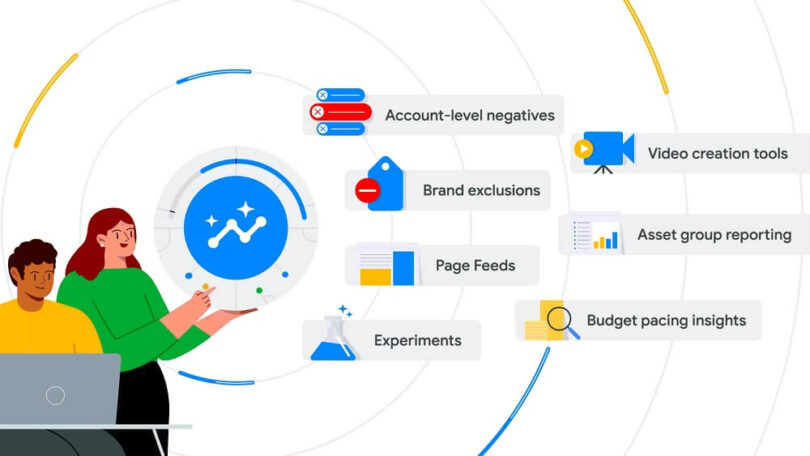Navigating the Shifting Landscape of Google Ads
The year 2023 has brought significant developments to the ever-evolving world of Google. As we’ve covered before, the only constant in the world of Google Ads and digital marketing as a whole is change itself. In 2023, Google Ads continues to adapt to the dynamic currents of media, technology, and user preferences. These changes demand the attention of marketers worldwide, and as your trusted Media Stewards, we are here to guide you through some of these transformative updates, ensuring that you remain at the forefront of the paid search advertising landscape.
Advancements in AI
Arguably the most groundbreaking change in the Google Ads landscape in 2023 is the integration of AI into its user interface. This transformative shift was unveiled during May’s Google Marketing Live event, heralding the dawn of a “new era of AI-powered ads.” First comes the introduction of AI-powered chatbots, strategically designed to assist advertisers in overcoming the initial hurdles of creating new campaigns. This provides an alternative to the traditional, more manual campaign setup process, which for some presented a roadblock to getting started with Google Ads.
Moreover, Google’s venture into generative AI could revolutionize the creation of marketing assets. Generative AI is artificial intelligence that can automatically produce content, including copy, imagery and video. Google will be incorporating generative AI into various campaign types, such as Search and its AI-powered campaign type, Performance Max. This technology holds the potential to unlock unprecedented levels of creativity and efficiency, providing advertisers who lack the means to produce their own creative to create compelling and effective marketing assets.
Account Negatives
Another modification within Google Ads (to the rejoicing of PPC professionals everywhere) is the introduction of account-level negative keywords. In previous iterations, the scope of negative keywords was confined to campaign or ad group levels. Although advertisers could use negative keyword lists, the manual application to each campaign or ad group proved to be a time-consuming bottleneck in the process.
Enter account-level negative keywords. Advertisers can now designate specific words or phrases for exclusion at the broader account level, propagating their impact across all campaigns and ad groups. This shift streamlines the management of negative keywords, eliminating a previously cumbersome step.
In an era where Google Ads is increasingly automated and driven by AI strategies, this enhancement gives advertisers a welcomed sense of control. Amidst the evolving landscape where automation often takes the lead, this feature empowers advertisers with an additional layer of influence over the workings of their campaigns.
Brand Exclusions in Performance Max
Keeping with the overarching theme of advertisers regaining control, we’ll move on to a crucial update in the form of brand restrictions and exclusions introduced within Performance Max campaigns. Performance Max campaigns represent Google’s latest all-encompassing innovation, combining various Google media channels – spanning Search, Shopping, Display, YouTube, and Discovery – into a unified campaign powered by AI and machine learning.
Google’s eagerness to drive the adoption of Performance Max campaigns while advancing their technology has been evident. However, savvy marketers encountered reservations and roadblocks that tempered their full embrace of this campaign type. A significant concern was the lack of user control. Advertisers were essentially asked to entrust Google with their creative assets and targeting signals, with the expectation that Google would adeptly assemble these elements into compelling creatives and effectively reach their desired audience. For those who harbored skepticism towards Google’s omnipotence, this prospect could be unsettling.
A crucial implication of limited control over targeting was that Performance Max, designed to maximize performance, often overshadowed brand paid search campaigns and dominated organic search results for brand names. In essence, the outstanding performance of Performance Max campaigns often relied on brand traffic, with no means for advertisers to moderate this effect. Most brands maintain dedicated strategies for their brand presence in search engines, and the absence of control over their own brand names on Google was a formidable obstacle to overcome when considering the adoption of Performance Max campaigns. Moreover, this dominance of brand search traffic sometimes hindered Performance Max campaigns from effectively reaching and converting new customers, which is typically the primary goal for most Google Ads advertisers.
Acknowledging these concerns and reservations, Google took a significant step by introducing brand exclusions and restrictions. This move grants advertisers a higher degree of authority over how their brand name is used – or not used – in powering their Performance Max campaigns. In a rare demonstration of Google granting increased user control, it appears to be a strategic maneuver aimed at encouraging more users to explore Performance Max campaigns while steering them away from manual campaigns. Nevertheless, this is a welcome development, as it gives advertisers newfound confidence in putting Performance Max to the test.
Staying Up to Date
These changes only scratch the surface of Google updates this year, but we wanted to at least cover the big hitters in depth. 2023 has brought remarkable changes to Google Ads, with AI integration, account-level negatives, and enhanced control over brand exclusions in Performance Max campaigns leading the way. As we navigate these and other transformations into 2024, rest assured that our commitment to guiding you as Media Stewards remains unwavering. Stay tuned for more updates and insights as we continue to adapt and thrive in the ever-evolving world of digital marketing.










